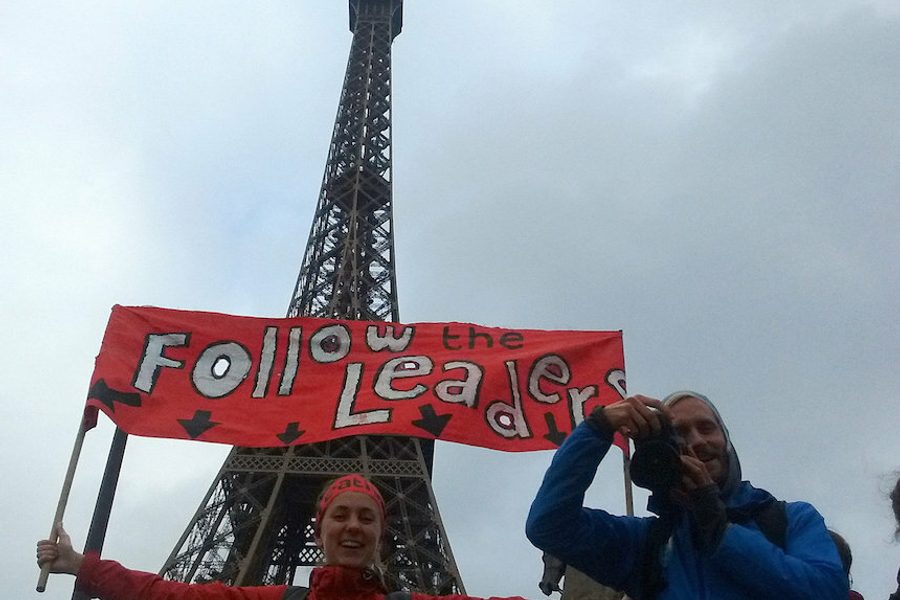The Paris Climate Agreement Sets Ambitious Goals, But Countries Won’t Achieve Them—Without Us
COP21’s heart may have been in the right place, but by the numbers, the sum is still climate catastrophe.
Tom Ladendorf

The result of the climate negotiations in Paris, which closed on Saturday, is a deal that world leaders have hailed as a historic success. President Obama has credited it with establishing an “enduring framework the world needs to solve the climate crisis”; UN Secretary-General Ban Ki-Moon called it a “monumental triumph for people and our planet”; and French President François Hollande described it as “ambitious, universal and legally binding.” And indeed, unlike 2009’s Copenhagen Accord, the Paris deal is actually legally binding, and creates an international structure for realizing the aggressive goals it lays out.
However, as climate activists, scientists and environmental groups have lamented, there is no reason to think that this structure will be an effective safeguard against catastrophic climate change. To be sure, the agreement’s target of a 1.5- to 2-degree Celsius temperature rise above pre-industrial levels would represent the aversion of climate change’s most disastrous consequences. But the deal makes no guarantee that this goal will be reached, and effectively pushes most of the hard decisions into the future.
This is because the “legally binding” core of the agreement is essentially just a requirement that member states track their progress toward emissions goals. These goals — known in the agreement as “intended nationally determined contributions,” or INDCs — are determined by and for individual signatory states. Starting in 2023, once every five years, each member state will resubmit its INDC and publish its progress toward its goals, following emissions reduction reporting standards that are part of the agreement.
At the time the agreement was reached, at least 185 (out of 196) countries had submitted INDCs outlining commitments to emissions reduction and mitigation. But the agreement openly acknowledges that the submitted INDCs are insufficient, noting that “much greater emission reduction efforts will be required than those associated with the intended nationally determined contributions in order to hold the increase in the global average temperature to below 2 ̊C above pre-industrial levels by reducing emissions to 40 gigatonnes [per year],” which it contrasts with the current projected carbon emissions level of 55 gigatons per year.
This means that implicit in the agreement is the expectation that each successive INDC a member state submits will have more ambitious emissions reduction goals. The idea of having more ambitious future goals is, of course, laudable, and we should certainly hope that the parties of COP21 become increasingly aggressive in their efforts to address climate change. But the fact that the emissions reductions goals that have been outlined for this “historic” climate agreement point us toward a temperature rise of as much as 3.5 degrees Celsius is not a cause for optimism.
And these commitments are tenuous at best, since the reporting and enforcement mechanisms are one in the same. The only actual consequence a member state will face for failing to meet its INDC goals is a sense of international shame at having failed to do its part.
We can hope that a dose of embarrassment, administered once every five years, will be enough to convince all the parties to COP21 to finally start moving toward carbon neutrality, but the American experience suggests otherwise. Republican legislators, persistent in their climate denial, never backed down from their rejection of Kyoto and have been open in their disdain for the COP21 negotiations. (Senate Majority Leader Mitch McConnell, for instance, warned that the agreement “is subject to being shredded in 13 months,” presuming a Republican president takes office.)
The serious limits of the agreement, apparent even before it was reached, is what led over 10,000 climate activists to take to the streets of Paris on Saturday and lay down what May Boeve, Executive Director of 350.org, calls the “red lines we cannot cross.” Carrying a nearly 350-foot long red banner reading “We won’t stop here. It’s up to us to keep fossil fuels in the ground,” protestors signaled to politicians that exceeding a 1.5 degrees Celsius temperature rise — the agreement’s most ambitious goal — is out of the question. Such “red lines,” in the form of signs, umbrellas, tulips, and more, were ubiquitous at the rally, which had as its slogan “We are nature defending itself.”
But the rally was, in fact, a brief deviation from France’s own red lines: an official exception for the march was made to the ban on demonstrations during the climate conference. This ban prevented huge mobilizations set for the start and end of the conference from taking place, in addition to civil disobedience actions planned throughout the two-week conference. While Saturday’s rally served as a consolation, it is hard to imagine how things might have been different if activists had been allowed to hold what would likely have been the largest climate actions ever.
All this said, despite its many limitations, the Paris accord is undeniably a landmark achievement. Unlike Copenhagen, it is legally binding; unlike Kyoto, the U.S. is a party to it and it includes developed and developing countries on similar terms. But given the many problems with the deal and the lackluster record of international climate agreements, we should be aware that it remains all too easy for us to cross serious red lines.
Keeping the vast majority of fossil fuels in the ground — which is necessary to limit warming to a 2 degrees Celsius rise — will take immense public pressure, as suggested by the efforts that successfully pushed politicians to reject Keystone XL. People, not politicians, have the power to maintain a livable climate for future generations. If we do not use it soon, it may be too late.

I hope you found this article important. Before you leave, I want to ask you to consider supporting our work with a donation. In These Times needs readers like you to help sustain our mission. We don’t depend on—or want—corporate advertising or deep-pocketed billionaires to fund our journalism. We’re supported by you, the reader, so we can focus on covering the issues that matter most to the progressive movement without fear or compromise.
Our work isn’t hidden behind a paywall because of people like you who support our journalism. We want to keep it that way. If you value the work we do and the movements we cover, please consider donating to In These Times.






